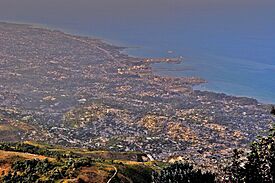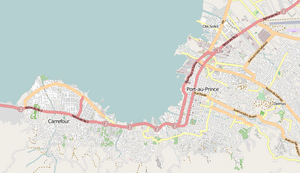Carrefour, Haiti facts for kids
Quick facts for kids
Commune of Carrefour
Kafou
|
|
|---|---|
|
Commune
|
|
| Motto(s):
Amour, Paix, Progrès
|
|
| Country | Haiti |
| Department | Ouest |
| Arrondissement | Port-au-Prince |
| Government | |
| • Type | Mayor–council |
| Area | |
| • Total | 165.16 km2 (63.77 sq mi) |
| Elevation | 39 m (128 ft) |
| Population
(2015 Est.)
|
|
| • Total | 511,345 |
| • Density | 3,096/km2 (8,020/sq mi) |
| Demonym(s) | Carrefourrois(e) |
| Zip code |
HT 6130
|
Carrefour (pronounced "car-foo") is a large town in Haiti. Its name means "Crossroads" in English. It is mostly a residential area, meaning many people live there. Carrefour is part of the Ouest department and the Port-au-Prince Arrondissement. In 2015, the town had about 511,345 people living there. Before the 1980s, Carrefour was a popular place for tourists to visit in Haiti.
Contents
History of Carrefour
The area where Carrefour is located started as a military post. In March 1795, two important Haitian leaders, Louis-Jacques Beauvais and André Rigaud, won a battle against English soldiers there.
Founding of Carrefour Village
On May 1, 1813, President Alexandre Pétion officially created the village of Carrefour. A surveyor named Louis Rigaud designed the village. It was planned to have 20 small islands and 161 building sites.
President Pétion's old home is in Carrefour. It is now the National School of Thor. This place is very important because it belonged to one of Haiti's founding fathers.
Later Conflicts and Development
In 1869, a rebel group called the Cacos took over Carrefour. They tried to attack a fort nearby but failed. Another group, the Piquets, then forced them out of Carrefour.
Later, in 1889, during another rebellion, an army group came to Carrefour. They fought battles near Bizoton but were defeated. President François Denys Légitime once planned to connect Carrefour to Port-au-Prince using steamboats.
Carrefour officially became a "commune" (a type of town or district) on December 15, 1982.
Geography of Carrefour
Carrefour is located at a very important crossroads. Thousands of vehicles pass through it every day. They travel to different parts of the West department and other departments like the Southeast, Nippes, South, and Grande–Anse. Because of its location and natural beauty, Carrefour has potential for business and tourism.
Urban and Rural Areas
For a long time, Carrefour was mainly an agricultural area. It supplied nearby towns and Port-au-Prince with farm products like rice, sugar, cotton, fruits, and coffee. But in the mid-1970s, the area started to become more urbanized. This happened as large landowners sold off their properties.
Carrefour is part of the larger Port-au-Prince area. This area also includes Petion-Ville, Kenscoff, Gressier, and Delmas. Carrefour has a large rural area with 13 "communal sections." These are smaller administrative divisions within the commune.
Landscape and Waterways
The landscape of Carrefour is similar to Port-au-Prince. It sits at the bottom of the Gulf of Gonave. It also has mountains and hills like Malanga and Chandelle.
The town's borders stretch from the coast near Fontamara to Port-au-Prince Bay. Its total area is about 190 square kilometers (about 73 square miles).
Carrefour has several rivers. The Froide River is one of the most important. Other rivers include Chauffard and Momance. There are also smaller streams and gullies.
Population Details
Carrefour has a population of over 500,000 people. It's one of the largest communes in Haiti by population. In 1982, it had about 129,470 people. By 2003, this grew to 373,916.
Communal Sections of Carrefour
A communal section is the smallest administrative area in Haiti.
- Morne Chandelle
- Platon Dufréné
- Taïfer
- Procy
- Coupeau
- Bouvier
- Lavalle
- Berly
- Bizoton
- Thor
- Rivière Froide
- Malanga
- Corail Thor
Postal Codes for Carrefour:
- HT6130: Carrefour
- HT6131: Bizoton
- HT6132: Diquini, Thor
- HT6133: Côte-Page, Mahotière
- HT6134: Arcachon, Warney
- HT6135: Brochette
- HT6136: Lamentin, Mariani, Merger
Economy in Carrefour
Unlike many other places in Haiti, farming is not the main part of Carrefour's economy. Carrefour's economy is more connected to Port-au-Prince. Most of its money comes from services and industries.
Farming and Local Businesses
However, some farming still happens in the rural communal sections. Farmers there grow coffee, vegetables, and grains. They also raise some animals like oxen and goats. Most of this farming is for families to feed themselves, not for big sales.
In the urban areas, the economy works like other big cities in Haiti.
Public Services and Industries
Carrefour has many public services in its main urban area. These include a courthouse, tax office, police station, and a Coast Guard office. It also has the country's largest sports complex.
There are many businesses too, such as banks, supermarkets, bakeries, and pharmacies. Industrial businesses include paint factories, metal companies, and oil companies.
Healthcare Services
Carrefour has two hospitals and many private clinics. These include Diquini Adventist Hospital and Carrefour Hopital Maternité. Even with these, many people from Carrefour still go to hospitals in Port-au-Prince for healthcare.
Education in Carrefour
Carrefour has many public and private schools. They offer education from primary (elementary) to secondary (high school), vocational (job training), and university levels. In the last 20 years, more schools have opened due to more people moving to the area and a greater need for education. Still, thousands of teenagers from Carrefour go to schools in Port-au-Prince.
List of Schools in Carrefour
- Ensemble Scolaire Père Basile Moreau (ESPBM)
- Juvénat du Sacré-Cœur
- Lycée Louis Joseph Janvier
- Collège Univers Frère Raphaël
- Collège Mixte Eddy Pascal
- Collège de Côte-Plage
- L'Ecole des Sœurs Salésiennes
- L'École Notre Dame de l'Assomption
- L'École Nationale de Thor
- Collège Catherine Flon
- Collège Alain Clerié
- Centre d'Études Secondaires
- Centre Polyvalent
- Collège Paul Etzer
- L'École République du Centre Afrique
- Le Lycée de Diquini
- Collège de Radio Lumière
- Collège Adventiste de Diquini
- L'Université Adventiste
Tourism in Carrefour
In the 1970s and 1980s, Carrefour was a very popular place for tourists. Both Haitians and visitors from other countries loved to go there. However, after the government changed in the late 1980s, the tourism industry in Carrefour almost disappeared.
Past Attractions
Some popular places in the past included the Méridien Club, Paradis des Amis Restaurant-Hotel, and Paladium Night Club. There were also hotels like Mermaid Beach Hotel and Auberge du Québec. The most famous spots were Lambi Night Club and Domaine Ideal, which was popular with foreign visitors. Many of these places were by the sea and had a nice breeze.
For entertainment, there were cinemas like the Coliseum and Cric Crac Cine. Cockfighting was also popular, especially at the Amical Gaguere de Mariani.
Religion in Carrefour
Carrefour has many different religions. People practice Catholicism, Vodou, Adventism, and other Christian faiths. Churches like Saint Charles and Our Lady of Mount Carmel attract large crowds for special festivals. The chapel of Saint Anthony is also a popular place for pilgrims.
Protestant Churches and Vodou
Protestant churches are found all over Carrefour. Their prayers and songs can often be heard late at night. This is a contrast to the dance music from nightclubs. There are also "houmforts," which are places where followers of Vodou worship African gods called "loas."
Social Work by Religious Groups
Many religious groups in Carrefour do important social work. Besides building impressive schools, some run orphanages, soup kitchens, and retreat centers.
History of the Parish
On December 10, 1905, the Carrefour parish (a church district) was officially created. It was first a small chapel dedicated to Saint Charles of Borome. Later, a group of monks called the Monfortains took over the parish. They built the church, a parish hall, and chapels in the communal sections.
The Carrefour Parish has eight chapels in different communal sections:
- Morne-a-Bateau (dedicated to Saint Antoine)
- Great River (Saint Paul)
- Morne-à-Chandelle (Saint Michel)
- Boucan Marie (Our Lady of the Annunciation)
- Bouvier (Holy Heart of Mary)
- Coupeau (Our Lady of Lourdes)
- Wiailles (Saint Francis Xavier)
- Côte-Plages (Our Lady of Perpetual Help)
Several religious communities also settled in Carrefour, including the Brothers of the Sacred Heart and the Salesian Sisters.
2010 Haiti Earthquake
On January 12, 2010, a very strong earthquake hit Haiti. It caused a lot of damage in Carrefour. About 40 to 50 percent of the buildings in the worst-hit areas were destroyed. The city's hospital was also damaged.
After the earthquake, the Cuban military set up a temporary hospital to help people. Electricity was brought back to some parts of the town in early February.
US Marine units also helped with relief efforts in Carrefour and nearby towns. By March 2010, new medical equipment, like an X-ray machine, arrived at the Adventists Medical Center to help with patient care.
See also
 In Spanish: Carrefour (Haití) para niños
In Spanish: Carrefour (Haití) para niños





